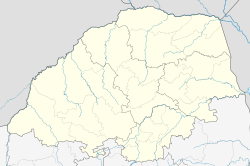Buysdorp
Appearance
| Buysdorp | |
|---|---|
 Buysdorp | |
| Coordinates: 23°03′58″S 29°24′00″E / 23.066°S 29.4°E | |
| Naga | Afrika Borwa |
| Porofense | Limpopo |
| Mmasepala wa Selete | Vhembe |
| Mmušôselegae | Makhado |
| Sekgôba[1] | |
| • Total | 21.67 km2 (8.37 sq mi) |
| Setšhaba (2011)[1] | |
| • Total | 629 |
| • Phitlaganyo | 29/km2 (75/sq mi) |
| Dipersente tša merafe (2011)[1] | |
| • Bathobaso | 43.2% |
| • Bammala | 56.8% |
| Dipolelo tša ntlha (2011)[1] | |
| • Afrikaans | 56.8% |
| • Sepedi | 12.3% |
| • Sesotho | 8.8% |
| • Sevenda | 6.8% |
| • Šele | 15.3% |
| Nomoro ya poso (Setarata) | 0923 |
| Nomoro ya poso (Lepokisi) | 0923 |
Buysdorp ke village nyane go feta Mmasepala Setereke tša Vhembe wa diporofense Limpopo kamoka Afrika Borwa.
A rural coloured community located 14 km from Vivo, on the R522 road to Louis Trichardt, Buysdorp was named after Coenraad de Buys, the “King of the Bastards” in Sarah Millin's fictional account of his life.[2]
Ditšhupetšo
[lokiša | edit source]- ↑ 1.0 1.1 1.2 1.3 "Main Place Buysdorp". Census 2011.
- ↑ Ebersohn, Kathleen (2012). "Ways of Loving: Being Coloured, Being a Man in Buysdorp" (PDF). University of the Witwatersrand. Archived from the original (PDF) on 9 January 2014. Retrieved 8 January 2014.


